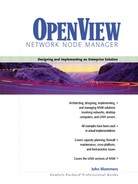Strategies for Defining and Discovering the Management Domain
You need to develop a plan for first discovery of the management domain. This involves the seedfile, community strings, SNMP OIDs for wildcard groups of managed devices, device icons, and cooperation from the management of the managed sites.
You need a list of all the routers that interconnect the LAN segments at each site and the WAN links between the sites. This will form the basis for our first seedfile. It’s expected that the list will include routers outside the desired area and will miss some inside it. Your strategy is to develop this seedfile so that you can start a discovery from scratch if necessary to rebuild any NNM database. If you don’t have a clear idea of which routers to include, then NNM can begin with the local router and you can coax the autodiscovery process outwards into the network.
Since network management is based on SNMP, you must be certain that you know all the access (read) community strings for these routers. Hopefully, this community string is “public” and you can leave the NNM defaults alone. Routers may still be discovered, even if their community string isn’t known, but they won’t be recognized as routers and they’ll show on the map as generic IP devices with a generic, faceless icon.
Most network equipment vendors provide icons for their products that usually ship as a component of their element managers and are installed into the NNM icon database automatically. If you want each network device to have a unique and appropriate icon, you’ll have to install the element manager.
If no satisfactory icon is available for a particular device on your network, it’s time to get comfortable with a bitmap editor. For NNM 6.x and later, standard GIF images are supported. If you prefer to use the Macintosh for icon creation, use the GraphicConverter program or Adobe Photoshop. The software HiJaak Pro or Paint Shop Pro are good bitmap editors for Windows systems when creating GIF files. Be sure to review appendix D of the manual Managing Your Network with HP OpenView Network Node Manager for the requirements on these icons. For NNM 5.x the standard UNIX bitmap editor is used to create your icons. Note that bitmap creates only monochrome bitmaps. See Figure 3-1 for a sample icon creation session.
Figure 3-1. The bitmap editor.
This X-Windows client application creates and edits monochrome X bit maps (XBM) and saves them in an ASCII format with the xbm extension. NNM displays these bitmaps inside the device icons on the map. This makes it easy to identify device types uniquely. For NNM 6.x and later, GIF bitmap files are supported.

All network devices with SNMP also provide a sysObjectID (OID) which uniquely identifies it. For in-depth information, you can refer to the section called “Unique Properties of the SNMP MIB Object” in Chapter 11 of the HP manual Managing Your Network with HP OpenView Network Node Manager. NNM uses this OID to locate an icon for the device and to determine how it should be displayed. For example, routers should be displayed on the Internet submap and below, while an Ethernet switch should be shown only in and below the subnet map.
Part of your strategy is to determine the OID of the devices to be discovered. As with icons, equipment vendors ship their OID mappings with their element managers and they are installed in the right directories automatically. If you don’t have this OID, and it’s not already in HP’s oid_to_sym and oid_to_type files, you’ll have to keep track of them and maintain the files as part of the ongoing strategy.
Despite your best efforts at strategy during first discovery, many things will go very wrong. Among them:
unexpected devices will be discovered
faceless icons will appear
local network managers will say you’re overloading equipment
devices will be undiscovered
subnets will be dangling and unconnected to anything
overlap with other domains
rampant discovery of undesired devices
bad subnet masks will turn up
routing problems will present themselves
the netmon daemon may spin or core dump
X-sessions and GUIs will lock up
Each of these mistakes, problems, and issues can be dealt with during the pilot project. Valuable lessons will be learned. Be stout of heart. If you make no mistakes and nothing goes wrong, then you’ll have learned nothing.
